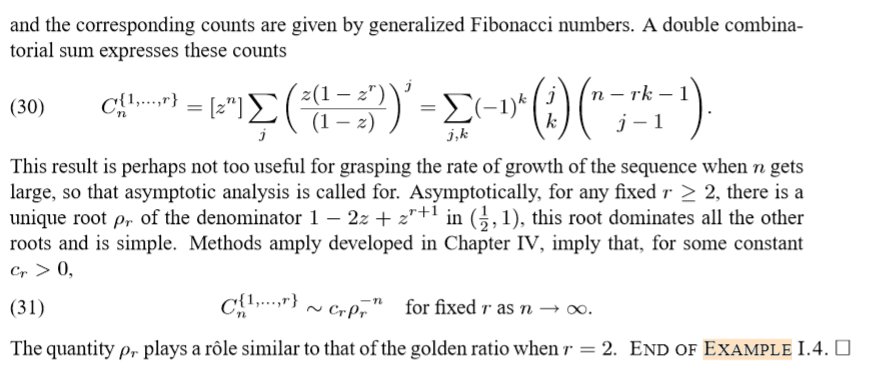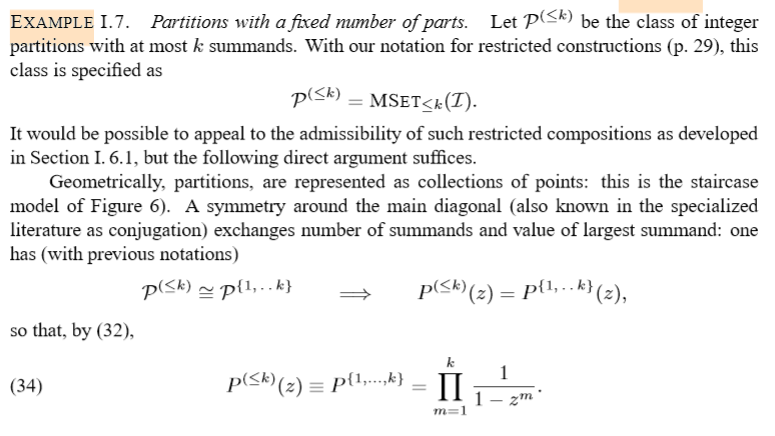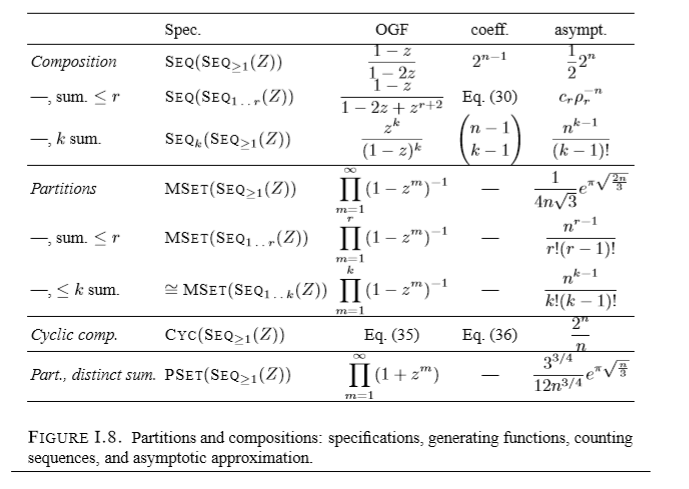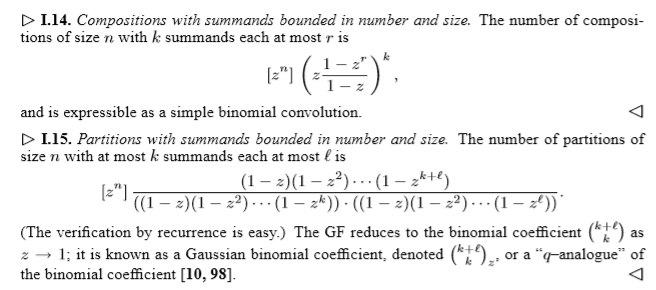【读书笔记】有序分拆和无序分拆的结论速览
composition是带序的分拆(不允许和数有0)
partition 是不带序的分拆(不允许和数有0)
Cyclic compositions (wheels)是说有序分拆,然后做个圆排列
Partitions into distinct summands. 字面意思
主要的研究方法是:
由组合对象间的关系推出或者直接写出OGF
然后如果好反演的话找到通项公式\(a_n=[z^n]f(z)\),不好反演就算了
接着通项简单的话直接分析渐进性质,否则用分析方法研究\(f(z)\)得到\(a_n\)的渐进性质
upd 2021-03-29 今天读了Stanley的《计数组合学·第一卷》第一章的开始的部分,里面提到了如何计数有如下的几种常见方法:
1.如果简单,直接写出显式公式
2.写出递推式和边界条件,也可以算是得到了可靠的结果
3.给出它关于变量的渐进估计
4.用生成函数描述
EXAMPLE I.4. Compositions with restricted summands


EXAMPLE I.5. Partitions with restricted summands (硬币找零问题)

(32)这里按我的想法解释的话,展开是\((1+x+x^2+...)(1+x^2+x^4+x^6+...)(1+x^3+x^6+x^9+...)...(1+x^r+x^{2r}+x^{3r}+...)\)
你第一个括号里拿的是\(x^4\),说明你的分拆里有4个1;...;你最后一个括号里拿的是\(x^{2r}\),说明你的分拆里有2个r

EXAMPLE I.6. Compositions with a fixed number of parts.

EXAMPLE I.7. Partitions with a fixed number of parts


结论表格

提醒一下,那个无限制的Composition个数是\(2^{n-1}\),智力题,想象\(n-1\)个隔板。拿mma求解可以用Combinatorica程序包里的Compositions函数
提醒一下,那个n的k部分Partition个数是\([z^n]z^k \prod\limits_{m=1}^{k}(1-z^m)^{-1}\)。mma代码就是IntegerPartitions[2010, {3}];Length@%
提醒一下,如果记\(p(n,k)\)是n的k部分的partition的方案个数,那么有\(p(n,k)=p(n-1,k-1)+p(n-k,k)\).证明是考虑最小的那个和数,如果是1对应于\(p(n-1,k-1)\)这一项,如果>1对应于\(p(n-k,k)\)这一项.更详细的解释看这个帖子。
最后还有一些

I.14写成显式公式就是
I.15用q-analogue很容易理解,可以看我写过的这篇文章
SEE ALSO
Restricted Weighted Integer Compositions and Extended Binomial Coefficients
Compositions of n with parts in a set
书主要涉及到的是Analytic Combinatorics
资料来自网络
Basic Hypergeometric Series这本书的8.10节也给出了一些公式
Let \(p(n)\) be the number of integer partitions of \(n\).
Hardy和Ramanujan在1918年给出\(p(n)\)在\(n\to \infty\)的渐近分析
(i)
\(p_N(n)\), the number of partitions of \(n\) into parts \(\leq N\), which is given by the g.f.
(ii)
\(p_e(n)\), the number of partitions of an even integer \(n\) into even parts, generated by
(iii)
\(p_{\text{dist}}(n)\), the number of partitions of \(n\) into distinct positive integers, generated by
where \(n=k_1\cdot 1 +k_2\cdot 2+\cdots +k_n \cdot n, \quad 0\leq k_i\leq 1,1\leq i\leq n\)
(iv)
\(p_0(n)\), the number of partitions of \(n\) into odd parts, generated by
分拆方案数里的一些等式
没记错的话是可以找到bijection的,可以看我的这个帖子。
Euler's partition identity
the bijection between case 1 and case 2.
- distinct parts
- all elements are odd
the bijection between these 2 cases:
- Integer partition of \(n\), all parts differ by \(\geq 2\), i.e. The so-called super-strict integer partition
- Integer partition of \(n\), \(\text{ distinct parts }\), \(\text{each even part}\) \(>2\cdot (\# \text{odd parts})\).


 浙公网安备 33010602011771号
浙公网安备 33010602011771号